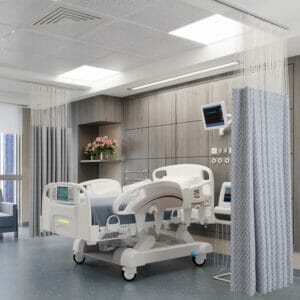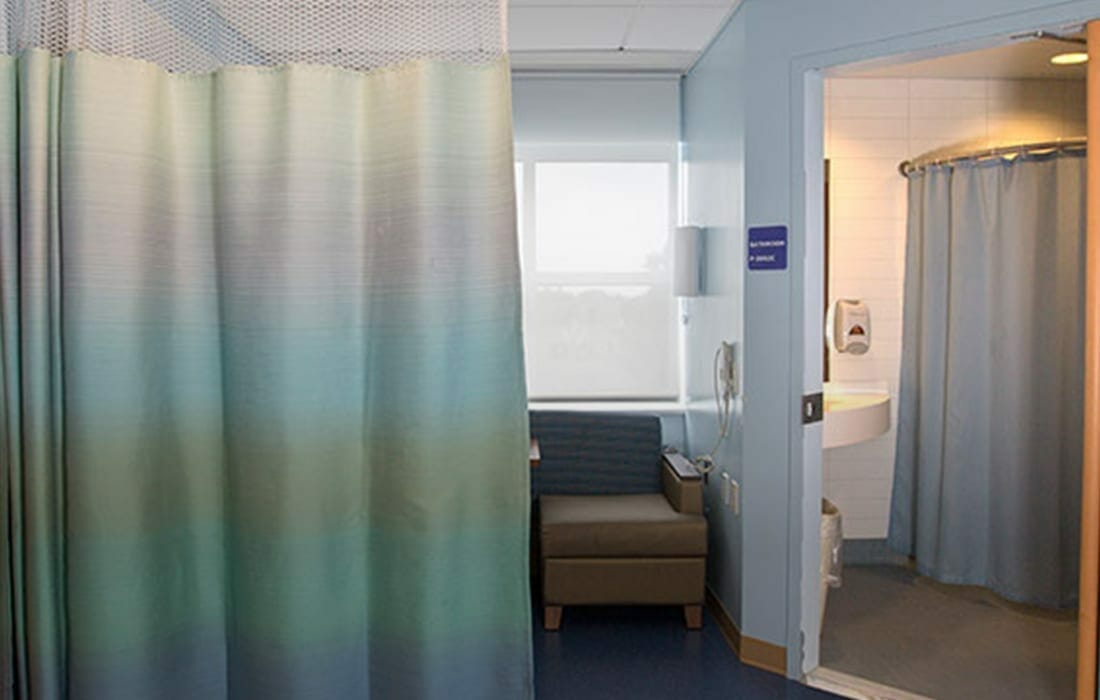Hospital privacy is crucial for ensuring patient comfort, dignity, and confidentiality. Healthcare facilities often face a choice between curtains and shades as the primary means of creating private spaces. Both solutions offer unique benefits and challenges, making it essential to evaluate them based on privacy, infection control, durability, and overall efficiency.
In this guide, we’ll explore the differences between hospital curtains and shades, assess their advantages and drawbacks, and help healthcare administrators determine the best privacy solution for their facilities.

The Importance of Privacy in Healthcare Settings
Privacy in hospitals is not just about patient comfort; it also plays a vital role in compliance with HIPAA regulations and infection control standards. Whether it’s a shared patient room, an ICU bay, or an emergency department, an effective privacy solution minimizes disruptions while maintaining hygiene and efficiency.
Hospitals must balance patient privacy, infection prevention, and cost-effectiveness when selecting between curtains and shades. Let’s break down the key aspects of both options.
Hospital Privacy Curtains: Features, Benefits, and Challenges
What Are Hospital Privacy Curtains?
Hospital curtains, often made from fabric or disposable materials, are commonly installed on ceiling-mounted tracks to create enclosed spaces. They are widely used in patient rooms, ICU units, and emergency departments where temporary partitions are necessary.
Benefits of Hospital Privacy Curtains
1. Cost-Effective and Easy to Install
Curtains are generally affordable and easy to replace, making them a cost-effective privacy solution. They can be installed quickly using curtain tracks, requiring minimal structural modifications.
2. Versatile and Flexible
Unlike rigid partitions, curtains offer flexibility in space management. They can be easily drawn or retracted, allowing hospital staff to adjust the space as needed.
3. Customizable Options
Hospitals can choose from a range of materials, colors, and antimicrobial-treated fabrics to enhance both aesthetics and hygiene.
4. Improved Airflow
Unlike solid barriers, fabric curtains allow for better air circulation, which can be beneficial in ensuring proper ventilation in healthcare settings.
Challenges of Hospital Privacy Curtains
1. Infection Control Concerns
Fabric curtains can harbor harmful bacteria and viruses, making them potential vectors for hospital-acquired infections (HAIs). If not replaced or cleaned regularly, they can pose significant health risks.
Read more about how disposable hospital curtains are revolutionizing infection control: Why Disposable Hospital Curtains Are Revolutionizing Infection Control
2. Frequent Maintenance Required
Traditional fabric curtains require regular laundering and disinfection, increasing operational costs and labor requirements.
3. Limited Light Control
While curtains provide visual privacy, they may not effectively block out light, which can be a concern in patient recovery areas where light exposure needs to be managed.
Hospital Privacy Shades: Features, Benefits, and Challenges

What Are Hospital Privacy Shades?
Privacy shades, also known as roller shades or medical blinds, provide a rigid or semi-rigid privacy solution. These shades are installed on windows or partitions and can be manually or automatically adjusted.
Benefits of Hospital Privacy Shades
1. Superior Infection Control
Shades, especially those made from antimicrobial materials, are easier to clean than fabric curtains. Since they have a non-porous surface, they do not trap bacteria, reducing the risk of contamination.
2. Enhanced Light Control and Comfort
Unlike curtains, shades can offer complete blackout options, which are beneficial in surgical areas, patient recovery rooms, and ICU units where light regulation is critical.
3. Sleek and Modern Appearance
Shades provide a cleaner and more streamlined look, enhancing the overall aesthetic appeal of hospital interiors.
4. Increased Durability
Made from materials like vinyl, aluminum, or composite fabrics, shades are more durable than fabric curtains. They resist wear and tear, making them a long-term investment.
Challenges of Hospital Privacy Shades
1. Higher Initial Cost
Compared to curtains, shades have a higher upfront installation cost, which may not be feasible for all healthcare facilities.
2. Limited Flexibility
Unlike curtains that can be drawn back for easy access, shades operate in a more structured manner, which may not always be convenient in fast-paced hospital settings.
3. Potential Maintenance Issues
Motorized or automatic shades require regular maintenance to ensure functionality. Mechanical failures can disrupt privacy and efficiency.
Learn more about the advantages of hospital curtain tracks and shades in privacy management: Hospital Curtain Tracks and Shades: Enhancing Privacy and Efficiency in Healthcare Settings
Curtains vs. Shades: Which Solution Works Best?
Best for Infection Control: Shades ✅
Since shades are made of non-porous and antimicrobial materials, they significantly reduce the spread of infections compared to traditional fabric curtains.
Best for Cost-Effectiveness: Curtains ✅
Hospitals with tight budgets may find curtains to be a more affordable option, especially if they opt for disposable curtains that reduce laundry costs.
Best for Light Control: Shades ✅
Shades offer better light regulation, making them ideal for ICUs, recovery rooms, and operating rooms.
Best for Flexibility and Ease of Use: Curtains ✅
If hospitals require quick and easy access to patients, curtains provide more flexibility in movement and space management.
Best for Aesthetic Appeal: Shades ✅
Shades provide a sleek and modern look, enhancing the hospital’s interior design while maintaining functionality.
The Ideal Privacy Solution for Modern Hospitals

For hospitals looking for a balance of privacy, infection control, and cost-effectiveness, a hybrid approach might be the best solution. Combining shades for windows and disposable curtains for patient partitions can provide optimal privacy while reducing infection risks.
HAIGuard™ specializes in advanced hospital privacy solutions, offering high-quality curtain tracks, disposable hospital curtains, and medical-grade shades to meet the unique needs of modern healthcare environments.
If your facility is considering upgrading its privacy solutions, exploring the latest infection-resistant curtains and shades can enhance both patient care and operational efficienc
By integrating both solutions strategically, hospitals can achieve maximum privacy, improved infection control, and better patient experiences. To learn more about the latest hospital privacy solutions, visit HAIGuard™ today.
Related Articles:
- Hospital Curtain Tracks and Shades: Enhancing Privacy and Efficiency in Healthcare Settings
- Why Disposable Hospital Curtains Are Revolutionizing Infection Control
By investing in the right privacy solutions, hospitals can create a safer, more efficient, and patient-friendly environment that meets the highest healthcare standards.








